Sound wave theory 12
Audio dynamic range
- Video
- Script
Welcome to this tutorial on dynamic range.
Dynamic range is an essential concept for studio owners, but difficult to define in a single sentence. In fact the term has several different meanings. Therefore we are going to start with some examples.
Caption - Dynamic range example 1 - human hearing
The human auditory system is designed to accommodate a range of sound pressure levels, or volumes, most useful to our survival. From the quietest sound pressure, such as the disturbance of long grass in the breeze, to the loudest such as a nearby gunshot or approaching catastrophe, humans can hear a wide but not unlimited range of volumes.
The quietest sounds can be heard just above our threshold of hearing at 0 decibel, and the loudest just below our threshold of pain at 130 decibels. This range of sound pressure levels is referred to as dynamic range.
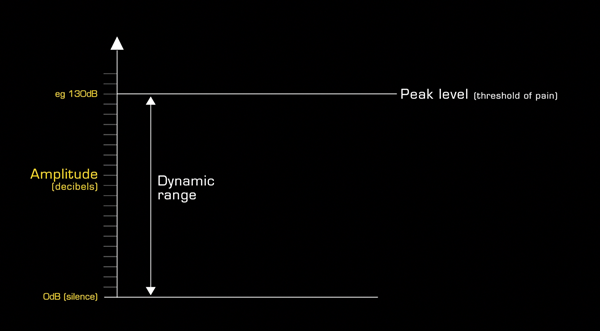
By the way, decibels are covered in a separate subject video.
Because sound travels in the air as a pattern of changing air pressure energy, decibels are a measurement unit for sound pressure levels, or SPL's for short. So decibels, SPL’s and dynamic range are all about volume and loudness.
Caption - Upper limit - peak level
When confronted by very loud sounds above 130 decibels, our auditory system is unable to cope, it simply has no way to represent them. Our hearing distorts and we may experience pain and short or long term hearing damage. We call 130 decibels the peak level and above it is clipping and distortion.
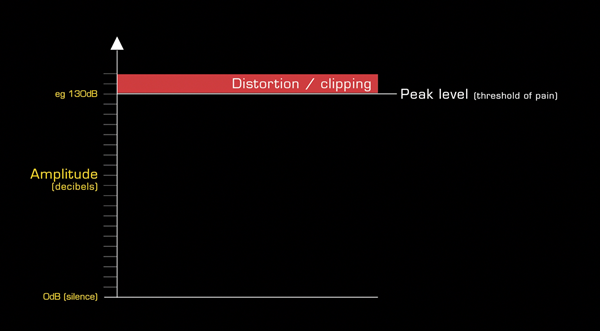
Caption - Lower limit - noise floor
Some sounds are too quiet to be heard, our sensitivity is simply not good enough. But sometimes we can't hear quiet sounds because they are masked by unwanted internal 'noise'. This noise could be tinnitus, a symptom of hearing damage that manifests itself as a perceived ringing or high frequency tone, or it could be the noise created by blood pumping through the structures of the auditory system. Hold your hands over your ears to see what internal noise you can hear.
We can draw a simple diagram showing the theoretical lower limit of human hearing, or silence, at 0 decibels, the noise above that, peak level and the threshold of pain, and distortion and clipping above that. The noise element is known as the noise floor. Our auditory dynamic range is between the noise floor and distortion.
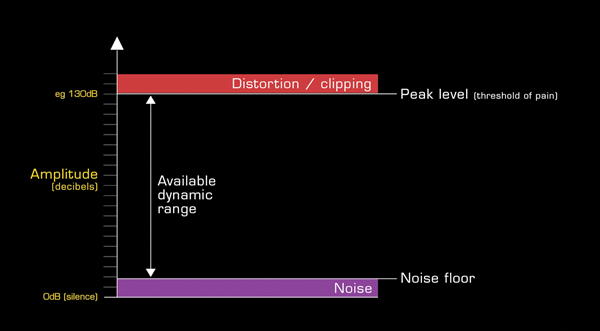
To sum up, the dynamic range of human hearing is not the difference between the quietest and loudest sounds that the human auditory system can accommodate, it is the difference between the quietest and loudest sound we can hear, or between the noise floor and peak level.
Caption - 'Dynamic range' definitions
'Dynamic range' doesn't just refer to human hearing, it can refer to any system that handles soundwaves, and also sound itself. The term 'Dynamic range' can be used to express ..
- the difference between silence and peak level
- the difference between the noise floor and peak level
- the difference between the quietest and loudest parts of a soundwave
- the difference between the quietest and loudest sounds that a musical instrument or sound source can generate
Caption - Wide and narrow dynamic range
If the dynamic range difference is large, it is said to be wide. If it is small it is said to be narrow.
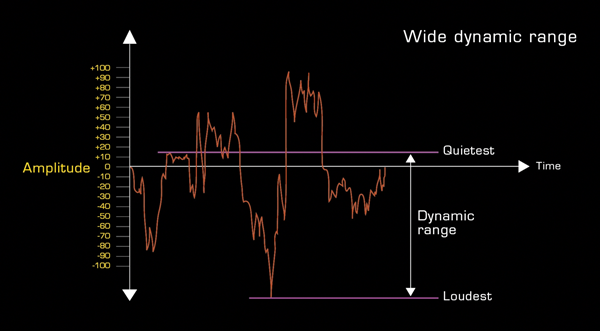
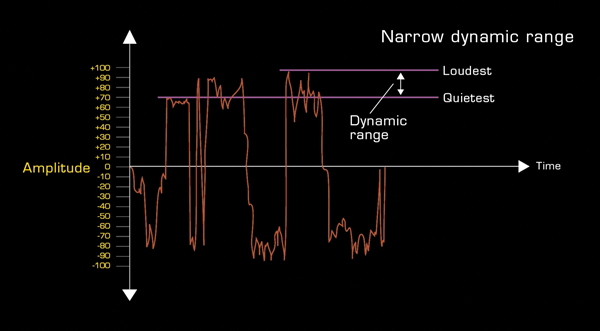
Caption - Signal to noise ratios
The relationship between the unwanted noise, and the wanted signal, or dynamic range, can be expressed as the signal to noise ratio. For audio equipment, the noise floor will be the unwanted noise produced by the electronics. Signal to noise ratios are usually calaculated from the noise floor level and a reference level.
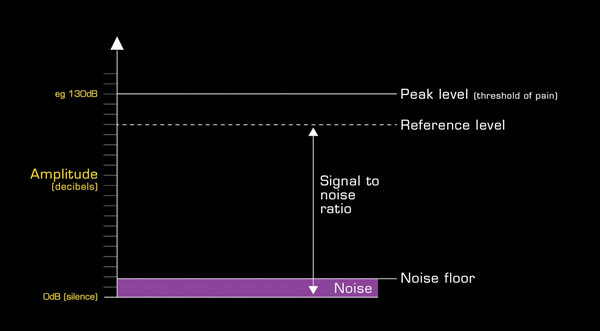
Signal to noise ratios are one of the specifications that are used to help determine the quality of electronic equipment. A high signal to noise ratio is almost always desirable because it means the noise is quiet and the dynamic range is wide.
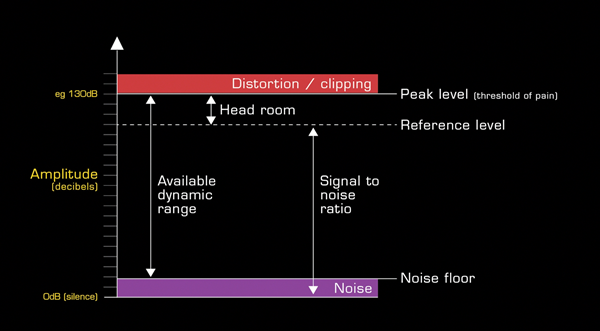
Caption - Dynamic range example 2 - microphones
A microphone's dynamic range is defined by its noise floor, its sensitivity to sound, and the maximum peak level signal it can accommodate.
Most microphones use an arrangement of a moving diaphragm and magnets to convert soundwaves in the air into electrical signals. In simple terms, the maximum travel of the diaphragm defines its peak level, and the efficiency of its design and electronics define its noise floor.
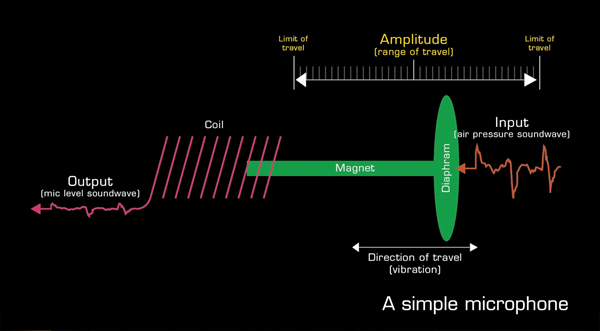
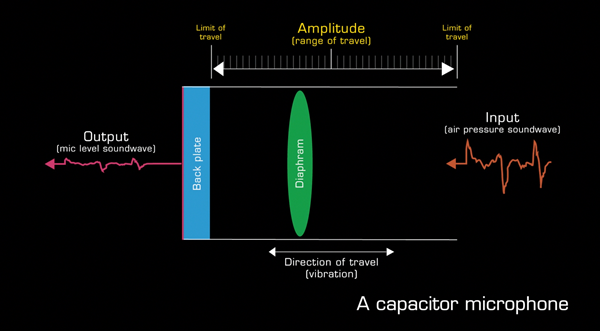
For example, the SE Electronics SE4400 has the excellent dynamic range and noise specifications we expect of modern capacitor mics. It can handle sound pressure levels of 130 decibels and its noise floor is at 17 decibels. The difference between these figures is its dynamic range.
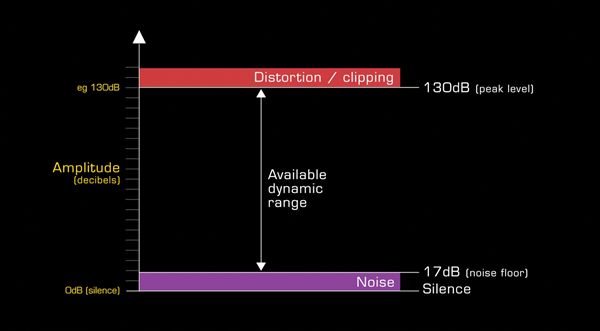
Caption - Dynamic range example 3 - audio processors
Audio processors such as compressors and EQs have dynamic range. In general, professional devices will have better quality components and be capable of a wider dynamic range than cost effective devices. This is especially important for devices that use valves or tubes, in order to achieve the best possible signal to noise ratio.
Caption - Dynamic range example 4 - musical instruments
The dynamic range of a musical instrument can be defined as the difference between the quietest and loudest sounds it can produce. Unless the instrument has some underlying operational noise, such as an analogue synthesiser, an accordion, or a pipe organ, there will be no noise floor. An acoustic guitar for example, is essentially silent until it is played.
Caption - Dynamic range example 5 - soundwaves themselves
The term dynamic range can also be used when talking about sound itself, especially music and conversational speech. Musical notes, pitch and words are not always sufficient to convey meaning. Dynamics play an equally important part. The dynamic range of a piece of music or speech will be the difference between its quietest and its loudest moments.
Caption - Wide dynamic range
Classical music in particular is adept at utilising wide variations in volume. We would say that such a piece of music has wide dynamic range.
Caption - Narrow dynamic range
On the other hand, much pop music is performed and recorded to be loud all the time, so it grabs attention, and therefore is said to have narrow dynamic range.
Caption - Thanks for watching
The script for this video, with accompanying images, can be found at projectstudiohandbook.com
We suggest you subscribe at our YouTube channel, and join our mailing list at our website to receive notification of new videos, blog posts and subscriber only extras.
Thanks for watching.